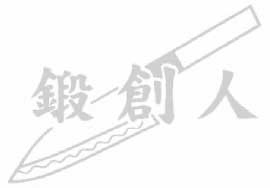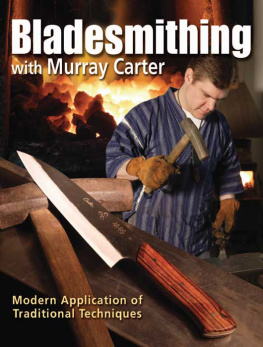BLADESMITHING
with Murray Carter

Modern Application of Traditional Techniques

Dedication
T his book is dedicated to all the people who have positively shaped my life. Surely each one mentioned here knows in what way, shape or form they influenced me, without specifically mentioning it here. Thanks go out to Major Skipper, David Dibblee, Suzette Dibblee, Charles Bunce, Danny Mosher, Tim Curnew, Dave Griffin, Mike Delaney, Billy Doan, Eddy Maskinie, James Hickling, Jim Aamon, Arnold Schwarzenegger, Kyohei Kugishima, Yasuyuki Sakemoto, Seiichi Hayashi, Red Fox Nakashima, Hiroshi Mori, Chitose Sensei, Chimata Uchida, Baikuya Saruwatari, Tim McCalla and Wes Injerd; Corrina Peterson, my editor; my parents and siblings; Bill Gibson and the mighty men of HOFCC; my dear children, Tetsuo, Emily, Alisa and Maria; my gracious wife Rumiko; and especially my Lord and Savior, Jesus Christ.

Preface
Artist /Craftsman/Artisan
In my opinion, there is a very important distinction between the artist, the craftsman and the artisan.
The Artist
An artist is someone who has an idea or image in their head, and to them it becomes an obsession to transfer that which is in their mind out into the world. Like a baby which has been conceived, the mother must deliver that baby into the world or suffer major physiological and emotional complications. To the artist it often feels like a matter of life and death. They feel like they might explode if they cant adequately express what is inside of them. Time, money, relationships, even their own health often takes second place to their artwork. Due to the nature of the artists priorities, it is often necessary for an artist to have a financially supportive patron or partner of some kind. The concept of daily wages has little meaning to the bona fide artist. While they are sometimes eccentric and difficult to understand, societies around the world owe a tremendous debt to artists. They have expanded our understanding of the world around us in every single subject, as they have innovated, invented and expanded the boundaries of what we knew as reality.
The Craftsman
The craftsman is someone who takes great delight in making things with their hands for people to use. They might be furniture makers, house builders or toy makers. They take pride in their work and seek recognition from colleagues and superiors, and usually improvement in their skills comes with time. One of the rewards for the craftsman is being able to see tangible results from his efforts. A craftsman is a practical person and is very much aware of the delicate balance of time and money. At the end of each day he counts his wages and starts to plan how he will spend his money on things that will give him even more pleasure than his work. The world owes much appreciation to the craftsmen of the world who provide us with an abundance of finely crafted household items.
The Artisan
The artisan is a rare mix between the artist and the craftsman. At first glance the work of an artisan may seem to qualify him as an artist because of uniqueness and outstanding workmanship. However, the all-telling clue as to the artisans true identity is that his children are not starving and his bills are paid. The artisan, while he may have an artistic bent which he indulges from time to time, is also acutely aware of costs, expenses and earnings. The difference is that when the artisan expresses his artistic side, he can afford to, as he has budgeted his time for it.
I consider myself an artisan. If your aspiration is to get into full time bladesmithing, it is vitally important to identify which one of the above three workers you are. Disappointment and financial duress may result if you are unrealistic in your assessment of your personality. When in doubt, ask several people around you who know you best which one they think you are.
Murray Carter
April 2011

Introduction
T his book is written to provide the reader with an in-depth look into the whys and hows of traditional Japanese cutlery forging techniques and their modern applications. Because of the non-stop flow of inquiries Ive received to share the secret techniques I learned during 18 years in Japan, where I lived and worked as a village bladesmith, it seemed appropriate to share that wealth of information for the benefit of the curious reader and Japanese knife enthusiast alike. It is my hope that those who own the nearly 15,000 knives Ive made will be delighted to see a comprehensive book written by their creator.
Ive attempted to write in a manner that will appeal to an international knife audience, to collectors and users of fine Japanese woodworking tools, and to some degree, those who are fascinated with the small handful of foreigners who have made unique inroads into the traditional Japanese arts, which have seemed impenetrable ever since the American Commodore Matthew C. Perry forced Japan to open its doors to the rest of the world in 1854.
I hope to provide a unique and extremely rare insight into the Japanese culture through the (blue) eyes of a Japanese village bladesmith, including detailed explanations of traditional bladesmithing techniques that until now have been cloaked in mystery and myths. My goal is provide enough detailed information to guide a new aspiring bladesmith to become successful in the Japanese style of blade making.
A 17th-generation Yoshimoto bladesmith, I am the only Caucasian ever to have been recognized as a Japanese bladesmithing master. I speak and read the Japanese language fluently, and have been gifted in the area of communicating with the native Japanese to a degree that is extremely uncommon in any industry. I am equally adept at forging traditional Japanese cutlery and outdoor knives. I am also the sole instructor of Murray Carters Bladesmithing School in Oregon, where I convey ancient Japanese bladesmithing skills and techniques.
Early Years
Born in Halifax, Nova Scotia, Canada, if one were to look at my comprehensive genealogy, he or she would recognize in my ancestors a repeating combination of hands-on craftsmen (farmers, a cobbler), a strong value placed on higher education, solid fiscal sense and strong religious convictions on both sides of the family. One look at my lifestyle and business practices today reveals that I remain true to my lineage, being a master craftsman, an accomplished teacher and businessman, and a Born Again believer in Jesus Christ.
As the only boy and the youngest, I often escaped into my own world, which consisted of TV, comic books and playing Lego. My favorite TV shows shared the common themes of survival, war, superhero-ism or adventure. Most memorable was the TV series Battle for Midway. Another favorite was the Bionic Man. Naturally, with this kind of background, I became fully drawn in, to the point of obsession, with the Star Wars series. I thought, If only I, too, could travel to a galaxy far, far away! Little did I know how those feelings would eventually take me a world away from my hometown of Halifax, all the way to Kumamoto, Japan.



















